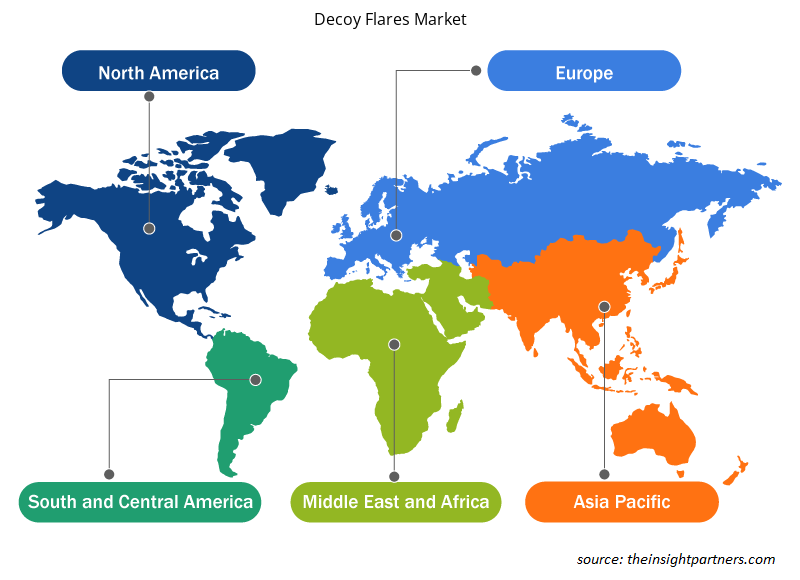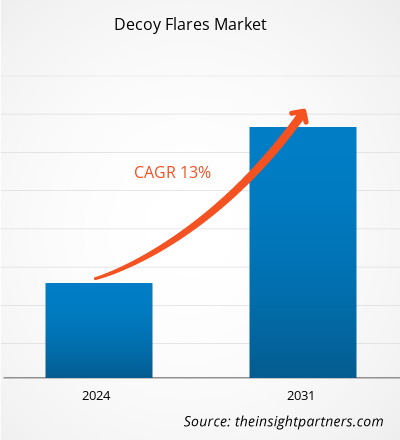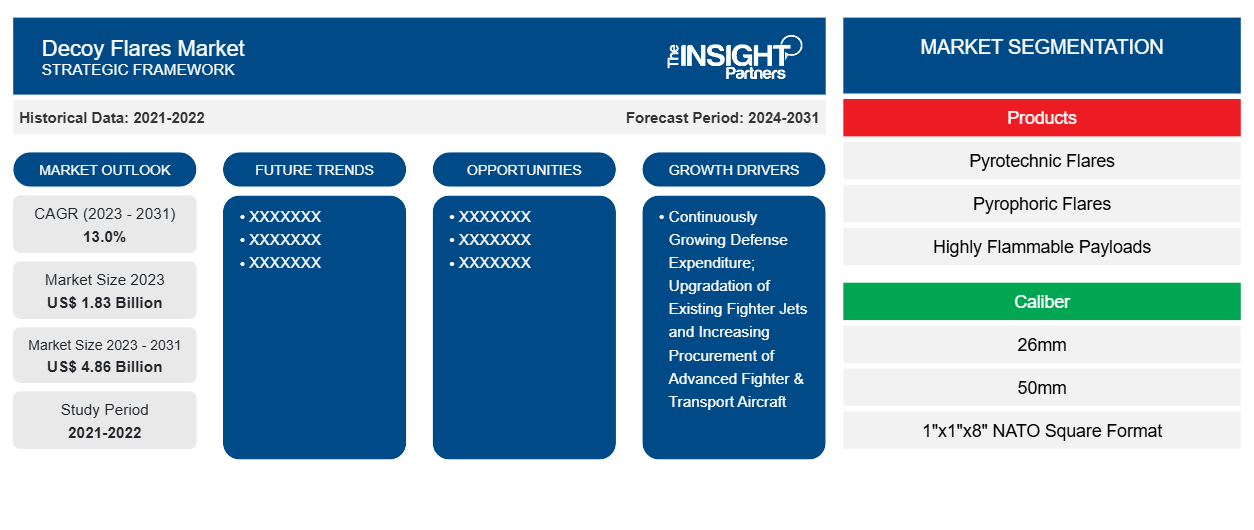Der Markt für Täuschkörper soll von 1,83 Milliarden US-Dollar im Jahr 2023 auf 4,86 Milliarden US-Dollar im Jahr 2031 anwachsen. Der Markt soll zwischen 2023 und 2031 eine durchschnittliche jährliche Wachstumsrate (CAGR) von 13,0 % verzeichnen. Die Einführung intelligenter Täuschkörper und Raketenstörkörper ist einer der wichtigsten Trends, der den Markt für Täuschkörper in den kommenden Jahren antreiben dürfte. Mehrere Länder haben diese in ihre jeweiligen Streitkräfte integriert, um ihre Waffen zu verbessern.
Marktanalyse für Täuschkörper
Die 1x1x8 Zoll großen quadratischen NATO-Täuschkörper gehören zu den am weitesten verbreiteten Kalibern für Täuschkörper. Dies liegt an der Vielseitigkeit des Kalibers, das sich in verschiedene Flugzeugmodelle integrieren lässt. Die nordamerikanischen und europäischen (außer Russland) Flugzeughersteller bevorzugen die Integration von 1x1x8 Zoll großen quadratischen NATO-Täuschkörpern. Zu den Flugzeugmodellen, die 1x1x8 Zoll große quadratische NATO-Täuschkörper tragen können, gehören Apache AH-64, F-16, A-10, Ch-47 Chinook, C-130 und A400M. Die Produktionsmengen der oben genannten Flugzeugmodelle steigen jedes Jahr weiter an, was die steigende Nachfrage nach 1x1x8 Zoll großen quadratischen NATO-Täuschkörpern widerspiegelt, die den Markt für Täuschkörper antreibt.
Marktübersicht für Lockfackeln
Die wichtigsten Akteure auf dem Markt für Täuschkörper sind Rohstofflieferanten, Täuschkörperhersteller und Endverbraucher. Die Hersteller von Täuschkörpern beschaffen ständig Rohstoffe von den Lieferanten, um größere Mengen an Täuschkörpern zu produzieren und so die Nachfrage der Kunden zu decken. Die zur Herstellung von Täuschkörpern verwendeten Rohstoffe umfassen chemische Energiesubstanzen (pyrotechnische Komponenten) und Granaten. Die Verfügbarkeit einer großen Anzahl von Rohstofflieferanten ermöglicht es den Akteuren auf dem Markt für Täuschkörper, den geeigneten Lieferanten auszuwählen. Dies verbessert die Lieferkette des Marktes für Täuschkörper. Nach der Beschaffung der Rohstoffe produzieren die Akteure auf dem Markt für Täuschkörper erhebliche Mengen an Täuschkörpern mit unterschiedlichen Kalibern und erfüllen so die jeweiligen Kundenanforderungen. Zu den Endverbrauchern auf dem Markt für Täuschkörper gehören Flugzeug-/Hubschrauberhersteller und die Verteidigungskräfte. Diese Endverbraucher benötigen erhebliche Mengen an Täuschkörpern, um diese in neuere Flugzeugmodelle sowie in bestehende Flotten zu integrieren.
Passen Sie diesen Bericht Ihren Anforderungen an
Sie erhalten kostenlos individuelle Anpassungen an jedem Bericht, einschließlich Teilen dieses Berichts oder einer Analyse auf Länderebene, eines Excel-Datenpakets sowie tolle Angebote und Rabatte für Start-ups und Universitäten.
-
Holen Sie sich die wichtigsten Markttrends aus diesem Bericht.Dieses KOSTENLOSE Beispiel umfasst eine Datenanalyse von Markttrends bis hin zu Schätzungen und Prognosen.
Markttreiber und Chancen für Lockfackeln
Steigende Beschaffung von Kampfflugzeugen und Hubschraubern
Die weltweit steigende Beschaffung von militärischen Kampfflugzeugen und Kampfhubschraubern ist einer der Hauptfaktoren, die die Installation von Täuschkörpern in verschiedenen Regionen vorantreiben. So vergab das US-Verteidigungsministerium im April 2023 einen Auftrag im Wert von 7,8 Milliarden US-Dollar an Lockheed Martin Corporation für die Modifizierung von 126 Einheiten des Mehrzweckflugzeugs F-35. Ebenso unterzeichneten die deutsche Bundeswehr und Airbus Helicopters im Dezember 2023 einen Vertrag über den Kauf von bis zu 82 Mehrzweckhubschraubern vom Typ H145M (62 Festbestellungen plus 20 Optionen). Darüber hinaus bestellte Spanien im Juni 2022 im Rahmen eines wegweisenden Vertrags 20 Eurofighter-Jets bei Airbus, um seine Kampfflugzeugflotte zu modernisieren. Solche Verträge haben die Stationierung von Täuschkörpern in Militärflugzeugen und -hubschraubern vorangetrieben .DoD awarded a contract worth US$ 7.8 billion to Lockheed Martin Corporation for the modification of 126 units of F-35 multi-role aircraft. Similarly, in December 2023, the German Bundeswehr and Airbus Helicopters signed a contract for the purchase of up to 82 multi-role H145M helicopters (62 firm orders plus 20 options). Additionally, in June 2022, Spain ordered 20 Eurofighter jets from Airbus under landmark contract to modernise its combat aircraft fleet. Such contracts have been pushing the deployment of decoy flares into the military aircraft and
Einsatz von Kampfdrohnen soll das Marktwachstum in den kommenden Jahren vorantreibenUAVs to Drive the Market Growth in The Coming Years
Die zunehmende Beschaffung von Militärdrohnen für ISR- und Kampfeinsätze ist ein weiterer wichtiger Faktor, der in den kommenden Jahren wahrscheinlich neue Möglichkeiten für Anbieter auf dem Markt für Täuschkörper schaffen wird. Mehrere Länder haben begonnen, Kampfdrohnen in ihre jeweiligen Militärflotten aufzunehmen, um ihre Kriegsführungsfähigkeiten zu verbessern, was auch den Markt für verschiedene Arten von Waffen und Gegenmaßnahmensystemen antreibt. Darüber hinaus hat Russland laut mehreren Quellen aus dem Verteidigungssektor kürzlich (im Jahr 2024) Raketen mit Täuschkörpern auf ukrainischem Territorium stationiert, um die ukrainischen Radare zu übertreffen. Solche aufkommenden Anwendungen werden im Prognosezeitraum wahrscheinlich neue Möglichkeiten für Marktanbieter schaffen.ISR & combat operations is another major factor likely to generate new opportunities for decoy flare market vendors in the coming years. Several countries have started deploying combat drones into their respective military fleets to advance their warfare capabilities which is driving the market for different types of weapons and countermeasure systems as well. Further, as per several defense sector sources, Russia recently (in 2024) have deployed decoy flares-based missile into Ukraine’s territory to surpass the Ukrainian radars. Such emerging applications are likely to generate new opportunities for market vendors during the forecast period.
Marktbericht zu Lockfackeln – Segmentierungsanalyse
Wichtige Segmente, die zur Ableitung der Marktanalyse für Lockfackeln beigetragen haben, sind Produkte, Kaliber, Anwendung und Geografie.
- Basierend auf den Produkten wurde der Markt für Täuschkörper in pyrotechnische Leuchtraketen, pyrophore Leuchtraketen und leicht entzündliche Nutzlasten segmentiert. Das Segment der leicht entzündlichen Nutzlasten hatte im Jahr 2023 einen größeren Marktanteil.
- Nach Kaliber wurde der Markt für Täuschkörper in 26 mm, 50 mm, 1 x 1 x 8 Zoll NATO-Quadratformat und 2 x 1 x 8 Zoll NATO-Quadratformat unterteilt. Das Segment des NATO-Quadratformats 1 x 1 x 8 Zoll hatte im Jahr 2023 den größten Marktanteil.
- Basierend auf der Anwendung wurde der Markt für Täuschkörper in Starrflügel- und Drehflügelflugzeuge unterteilt. Das Starrflügelsegment hielt im Jahr 2023 einen größeren Marktanteil.
Marktanteilsanalyse für Täuschkörper nach geografischer Lage
Der geografische Umfang des Marktberichts für Lockfackeln ist hauptsächlich in fünf Regionen unterteilt: Nordamerika, Europa, Asien-Pazifik, Naher Osten und Afrika sowie Südamerika.
Nordamerika dominierte den Markt für Täuschkörperraketen im Jahr 2023, während die Region Asien-Pazifik im Prognosezeitraum voraussichtlich ein deutliches Wachstum verzeichnen wird. Geografisch gesehen ist Nordamerika der größte Investor auf dem Markt für Täuschkörperraketen, da in der Region eine große Anzahl von OEMs für Militärflugzeuge vertreten ist. Zu den Akteuren gehören Unternehmen wie Lockheed Martin Corporation, Boeing, General Dynamics und Airbus. Darüber hinaus wird die Nachfrage nach Täuschkörperraketen in Nordamerika auch durch die Präsenz der USA angetrieben, die das Land mit den höchsten Militärausgaben weltweit sind und im Vergleich zu jedem anderen Land weltweit über die größte Flotte an Militärflugzeugen und -hubschraubern verfügen. Solche Faktoren haben das Wachstum des Marktes für Täuschkörperraketen in der Region Nordamerika vorangetrieben.
Regionale Einblicke in den Markt für Lockfackeln
Die regionalen Trends und Faktoren, die den Markt für Täuschfackeln während des Prognosezeitraums beeinflussen, wurden von den Analysten von Insight Partners ausführlich erläutert. In diesem Abschnitt werden auch die Marktsegmente und die Geografie für Täuschfackeln in Nordamerika, Europa, im asiatisch-pazifischen Raum, im Nahen Osten und Afrika sowie in Süd- und Mittelamerika erörtert.

- Erhalten Sie regionale Daten zum Markt für Lockfackeln
Umfang des Marktberichts zu Lockfackeln
| Berichtsattribut | Details |
|---|---|
| Marktgröße im Jahr 2023 | 1,83 Milliarden US-Dollar |
| Marktgröße bis 2031 | 4,86 Milliarden US-Dollar |
| Globale CAGR (2023 - 2031) | 13,0 % |
| Historische Daten | 2021-2022 |
| Prognosezeitraum | 2024–2031 |
| Abgedeckte Segmente |
Nach Produkten
|
| Abgedeckte Regionen und Länder |
Nordamerika
|
| Marktführer und wichtige Unternehmensprofile |
|
Marktteilnehmerdichte: Der Einfluss auf die Geschäftsdynamik
Der Markt für Decoy Flares wächst rasant, angetrieben durch die steigende Nachfrage der Endnutzer aufgrund von Faktoren wie sich entwickelnden Verbraucherpräferenzen, technologischen Fortschritten und einem größeren Bewusstsein für die Vorteile des Produkts. Mit steigender Nachfrage erweitern Unternehmen ihr Angebot, entwickeln Innovationen, um die Bedürfnisse der Verbraucher zu erfüllen, und nutzen neue Trends, was das Marktwachstum weiter ankurbelt.
Die Marktteilnehmerdichte bezieht sich auf die Verteilung der Firmen oder Unternehmen, die in einem bestimmten Markt oder einer bestimmten Branche tätig sind. Sie gibt an, wie viele Wettbewerber (Marktteilnehmer) in einem bestimmten Marktraum im Verhältnis zu seiner Größe oder seinem gesamten Marktwert präsent sind.
Die wichtigsten auf dem Markt für Lockfackeln tätigen Unternehmen sind:
- Armtec Verteidigungstechnologien
- Chemring Group PLC
- TARA Luft- und Raumfahrt AD
- TransDigm Group Incorporated
- Elbit Systems Ltd.
- LACROIX
Haftungsausschluss : Die oben aufgeführten Unternehmen sind nicht in einer bestimmten Reihenfolge aufgeführt.

- Überblick über die wichtigsten Akteure auf dem Decoy Flares-Markt
Neuigkeiten und aktuelle Entwicklungen zum Markt für Lockfackeln
Der Markt für Täuschfackeln wird durch die Erfassung qualitativer und quantitativer Daten nach Primär- und Sekundärforschung bewertet, die wichtige Unternehmensveröffentlichungen, Verbandsdaten und Datenbanken umfasst. Im Folgenden finden Sie eine Liste der Entwicklungen auf dem Markt für Täuschfackeln und Strategien:
- Im Januar 2024 sicherte sich Rheinmetall einen Vertrag (2024-2029) im Wert von 54,4 Millionen US-Dollar zur Lieferung von Täuschkörpern für Flugzeuge an die Bundeswehr. Im Rahmen dieses Vertrags wird Rheinmetall 470.000 Täuschkörper an die Berliner Streitkräfte liefern. (Quelle: Rheinmetall, Pressemitteilung/Unternehmenswebsite/Newsletter)
- Im Oktober 2021 erhielt Chemring Australia vom Naval Air Systems Command eine Vertragsänderung in Höhe von 18,69 Millionen US-Dollar (einschließlich 2,67 Millionen US-Dollar aus FMS-Mitteln) zur Herstellung und Lieferung von 9.728 MJU-68/B IR-Flare-Gegenmaßnahmen: 7.256 für die US Navy und 1.152 für die US Air Force; 528 für Norwegen; 336 für Japan; 312 für die Niederlande; und 144 für Italien. (Quelle: Chemring Group, Pressemitteilung/Unternehmenswebsite/Newsletter)
Marktbericht zu Lockfackeln – Abdeckung und Ergebnisse
Der Bericht „Marktgröße und Prognose für Lockfackeln (2021–2031)“ bietet eine detaillierte Analyse des Marktes, die die folgenden Bereiche abdeckt:
- Marktgröße und Prognose auf globaler, regionaler und Länderebene für alle wichtigen Marktsegmente, die im Rahmen des Projekts abgedeckt sind
- Marktdynamik wie Treiber, Beschränkungen und wichtige Chancen
- Wichtige Zukunftstrends
- Detaillierte Porter's Five Forces Analyse
- Globale und regionale Marktanalyse mit wichtigen Markttrends, wichtigen Akteuren, Vorschriften und aktuellen Marktentwicklungen
- Branchenlandschaft und Wettbewerbsanalyse, einschließlich Marktkonzentration, Heatmap-Analyse, prominenten Akteuren und aktuellen Entwicklungen
- Detaillierte Firmenprofile mit SWOT-Analyse
- Historische Analyse (2 Jahre), Basisjahr, Prognose (7 Jahre) mit CAGR
- PEST- und SWOT-Analyse
- Marktgröße Wert/Volumen – Global, Regional, Land
- Branchen- und Wettbewerbslandschaft
- Excel-Datensatz
Aktuelle Berichte
Erfahrungsberichte
Grund zum Kauf
- Fundierte Entscheidungsfindung
- Marktdynamik verstehen
- Wettbewerbsanalyse
- Kundeneinblicke
- Marktprognosen
- Risikominimierung
- Strategische Planung
- Investitionsbegründung
- Identifizierung neuer Märkte
- Verbesserung von Marketingstrategien
- Steigerung der Betriebseffizienz
- Anpassung an regulatorische Trends























 Kostenlose Probe anfordern für - Markt für Täuschfackeln
Kostenlose Probe anfordern für - Markt für Täuschfackeln